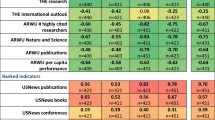Abstract
This article is focused on the government program for increasing competitiveness of Russian universities “5–top 100” started in 2013. The main aim of the program is creating necessary conditions for Russian universities for being ranked in the top-quality world rankings. Fifteen universities were carefully selected among many other institutions. The university funding amount for the next year directly depends on the current year results. We analyzed the results of universities participating and not participating in the program “5–top 100” for the years 2008–2014 within the university groups and with reference group as well as with world and country average values. Based on the analysis we can state that the program “5–top 100” enables not only participating universities to improve their current result. The program helps universities in prioritizing their aims and enhancing their competitiveness at the world level that is supported by positions in world university rankings.
Similar content being viewed by others
References
Anson, M. J. P., Fabozzi, F. J., & Jones, F. J. (2011). The handbook of traditional and alternative investment vehicles: Investment characteristics and strategies. New York: Wiley.
Decree of the Government of Russian Federation No. 211 (2013).
Decree of the President of Russian Federation No. 599 (2012).
Gogolev, G. (2015). University as the essential service core for modern market. In Materials of seminar—Conference on the implementation of plans according to the increasing competitiveness programs (“road maps”) (Vol. 4, pp. 16–17).
Kremer, M. (2003). Randomized evaluations of educational programs in developing countries: Some lessons. The American Economic Review, 93(2), 102–106.
Lukman, R., Krajnc, D., & Glavič, P. (2010). University ranking using research, educational and environmental indicators. Journal of Cleaner Production, 18(7), 619–628.
Povalko, A. (2014). Push for the top. Times Higher Education World University Rankings, 22.
Program “5–top 100” official site. Updated July 3, 2015; cited July 7, 2015. http://5top100.ru/universities/.
QS methodology of universities analysis. (2015). QS Quacquarelli Symonds Limited 1994–2015. Retrieved July 7, 2015, from http://www.iu.qs.com/university-rankings/qs-classifications/.
Schiermeier, Q. (2010). Russia to boost university science. Nature, 464, 1257.
Sokolov, M. (2015). The sources of post-soviet professional power. Higher Education in Russia and Beyond (HERB), 4, 10–11.
SciVal database. (2015). Updated May 5, 2015; cited July 7, 2015. http://scival.com/.
Acknowledgments
This research was carried out in Scientific Research Institute—Federal Research Centre for Projects Evaluation and Consulting and financed with the support of the Ministry of education and science of the Russian Federation according to the State Task No. 2015/N7 project No. 3253 “Organization and monitoring of innovative activity the subjects of the Russian Federation”.
Author information
Authors and Affiliations
Corresponding author
Rights and permissions
About this article
Cite this article
Turko, T., Bakhturin, G., Bagan, V. et al. Influence of the program “5–top 100” on the publication activity of Russian universities. Scientometrics 109, 769–782 (2016). https://doi.org/10.1007/s11192-016-2060-9
Received:
Published:
Issue Date:
DOI: https://doi.org/10.1007/s11192-016-2060-9
Keywords
- University ranking
- Government increasing university competitiveness program
- FWCI
- Research institutions
- Regional development
- Policy making












